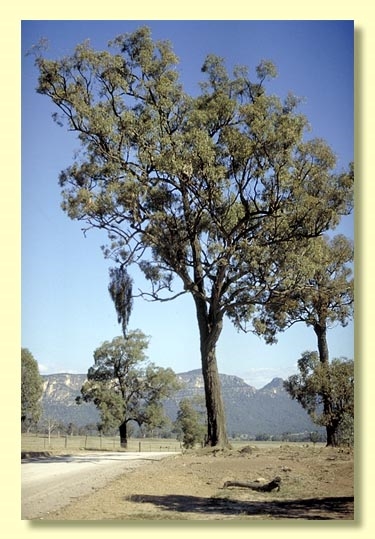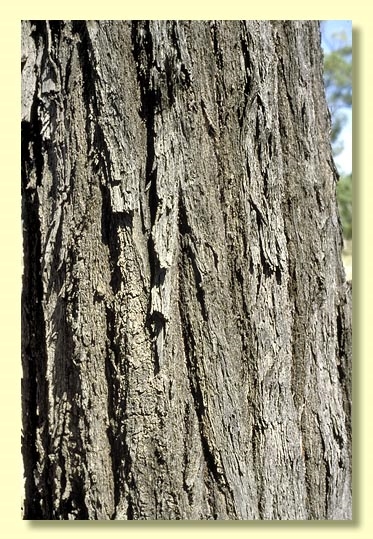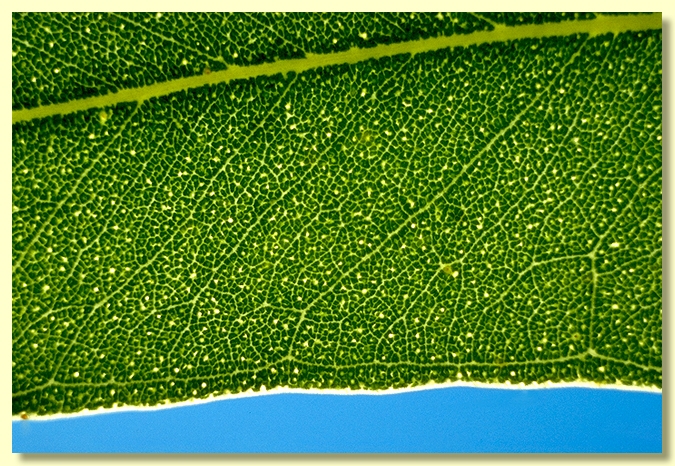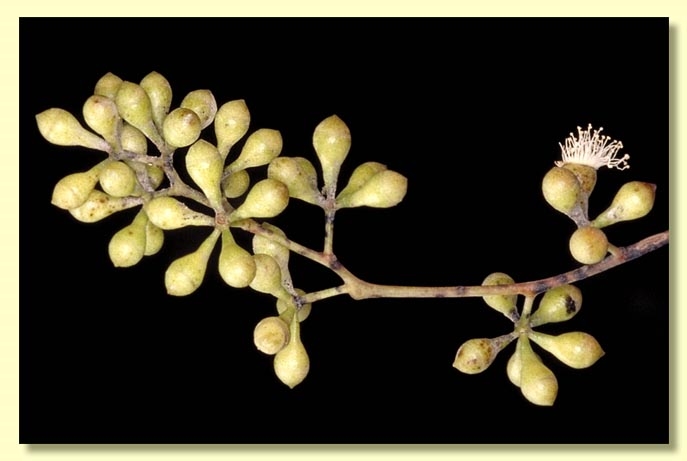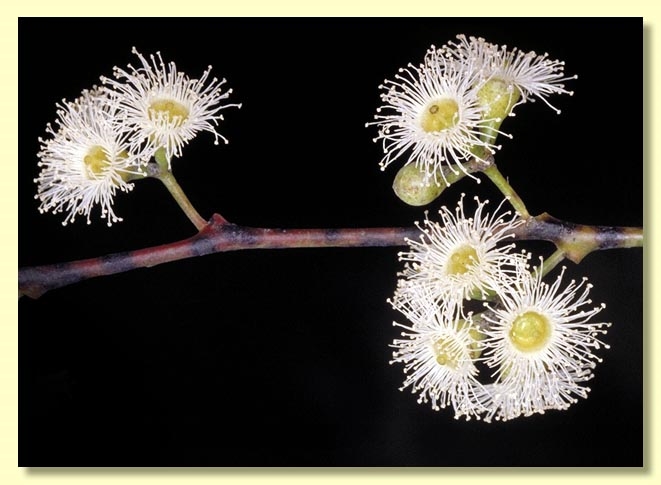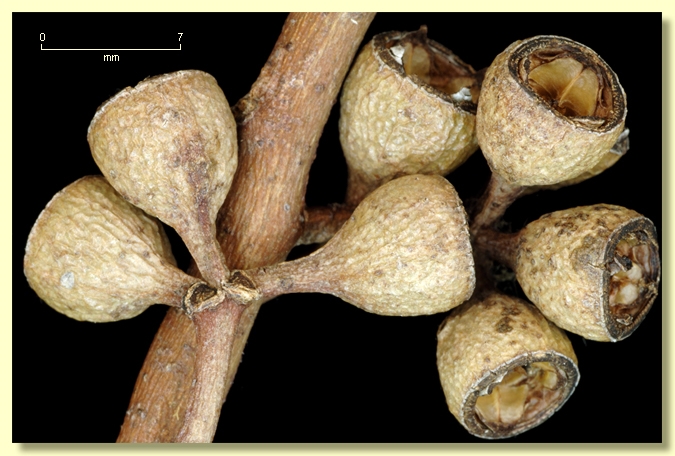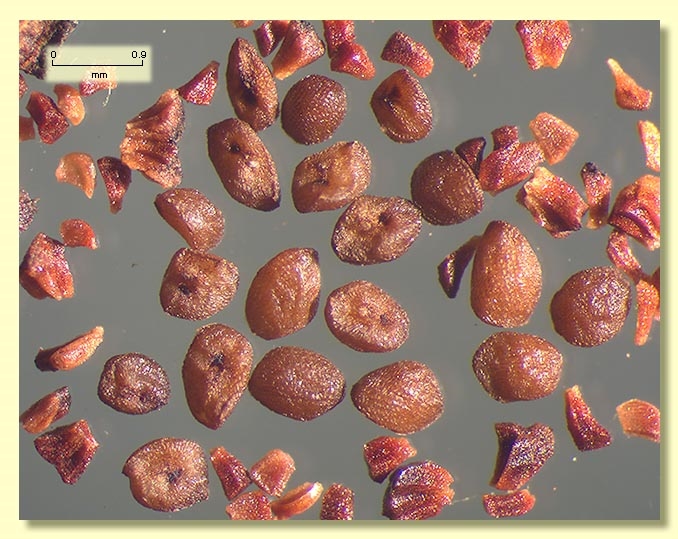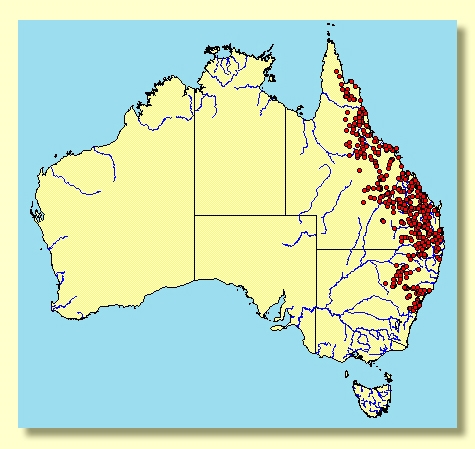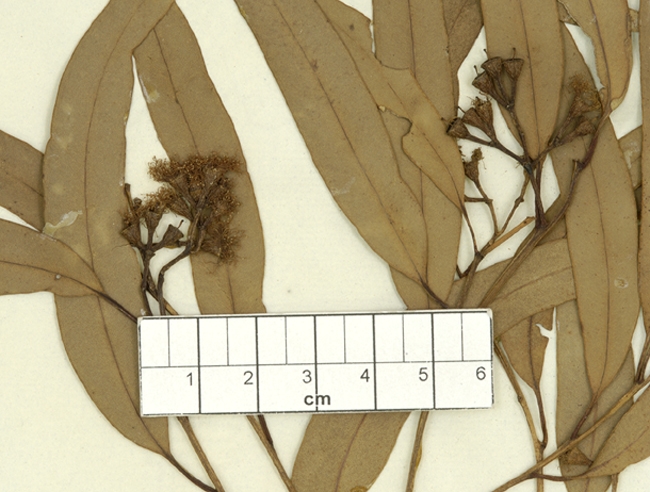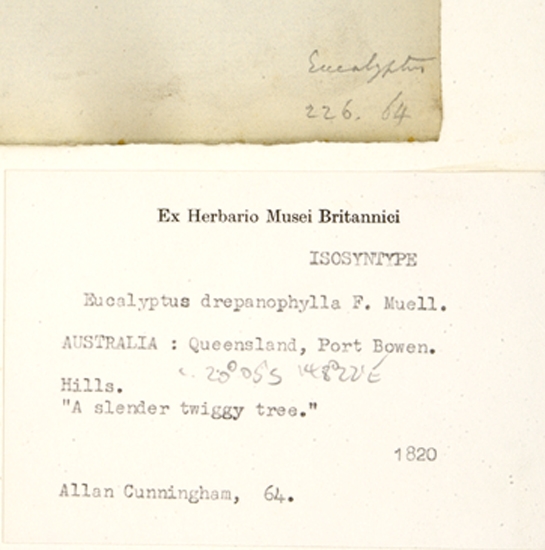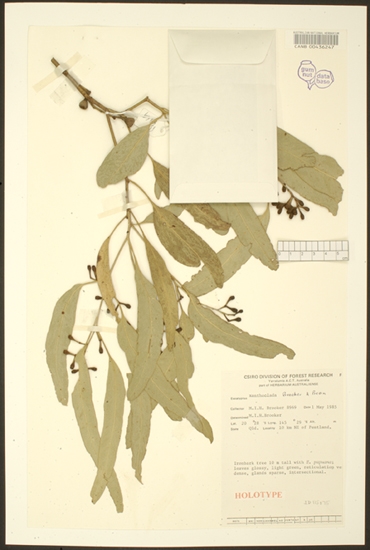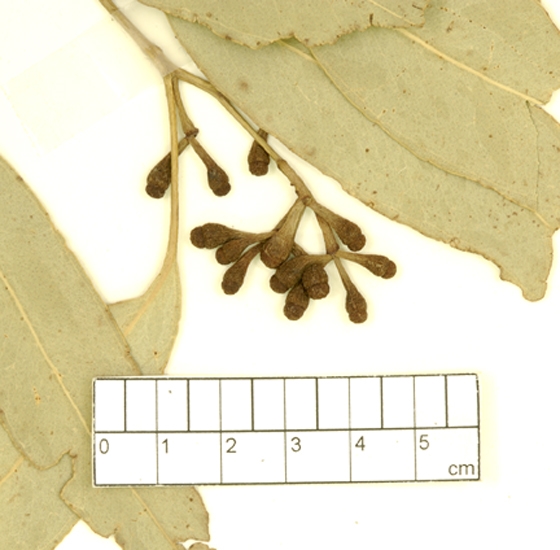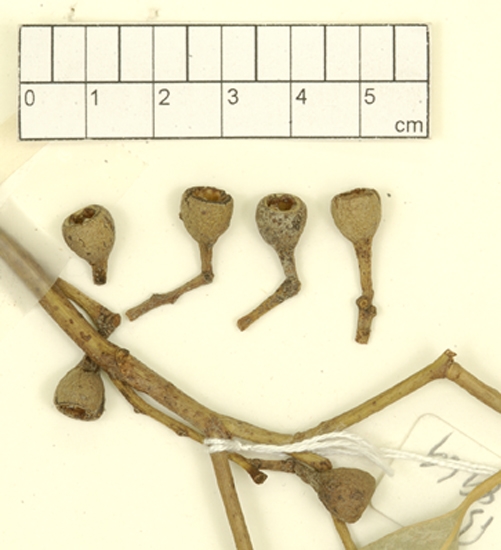Euclid - Online edition
Eucalyptus crebra
Eucalyptus | Symphyomyrtus | Adnataria | Apicales | Siderophloiae | Subglaucae
T: Burdekin, Qld, 10 Nov. 1856, F.Mueller s.n.; holo: MEL. (see image of type specimen held at MEL)
Metrosideros salicifolia Sol. ex Gaertner, Frut. Sem. Pl. 1: 171 & t. 34 (left-hand part) (1788), non E. salicifolia Cav. T: Thirsty Sound, [Qld.], 1770, J.Banks & D.Solander.
Eucalyptus drepanophylla F.Muell. ex Benth., Fl. Austral. 3: 221 (1867). T: Edgecombe Bay, Port Denison, Qld., J.Dallachy s.n.; lecto: NSW; isolecto: BRI, K, MEL, fide J.H.Maiden, Crit. Revis. Eucalyptus 5: 262, 290 (1921).
Eucalyptus xanthoclada Brooker & A.R.Bean, Brunonia 10 (2) 193 (1987). T: Queensland: 10 km NE of Pentland, 1 May 1985, M.I.H.Brooker 8969 and A.R.Bean; holo: CANB; iso: BRI, NSW, MEL.
Ironbark to small branches, dark grey or black, hard and deeply furrowed.
Juvenile growth (coppice or field seedlings to 50 cm): stem rounded or square in cross-section; juvenile leaves opposite for a few pairs, then alternate, petiolate, linear, lanceolate or falcate, 5–12 cm long, 0.6–1.7 cm wide, grey-green or green.
Adult leaves alternate, petiole 0.7–2 cm long; blade linear to narrowly lanceolate to lanceolate, 5.5–18 cm long, (0.6)0.7–2.7 cm wide, base tapering to petiole, concolorous, dull, green to grey-green to rarely glaucous, side-veins at an acute or sometimes wider angle to midrib, densely to very densely reticulate, intramarginal vein parallel to and just within margin, oil glands mostly intersectional or obscure.
Inflorescence normally terminal compound, sometimes axillary single umbels, peduncles 0.2–1.3 cm long, buds 7, 9 or 11 per umbel, pedicels 0.2–0.7 cm long. Mature buds clavate to fusiform to diamond-shaped or ovoid, 0.3–0.7 cm long, 0.2–0.4 cm wide, green to yellow, smooth, scar present, operculum conical to rounded, stamens usually irregularly flexed, anthers adnate, globoid, dehiscing by broad lateral pores or slits, style long, stigma blunt or pin-head shaped, locules 3 or 4, the placentae each with 4 vertical ovule rows. Flowers white.
Fruit on pedicels 0.1–0.6(0.9) cm long, cup-shaped, barrel-shaped or hemispherical, 0.2–0.7 cm long, 0.25–0.6 cm wide, disc descending, valves 3 or 4, near rim level or enclosed.
Seeds brown or grey, 0.8–2 mm long, ovoid or flattened-ovoid or pointed at one end, dorsal surface shallowly pitted, hilum ventral.
Cultivated seedlings (measured at ca node 10): cotyledons reniform to oblong; stems square in cross-section; leaves always petiolate, opposite for ca 5 nodes then alternate, linear to lanceolate, 4–12.5 cm long, 0.3–2 cm wide, base tapering, dull, green to grey-green.
Flowering has been recorded in all months except February.
A small to medium-sized ironbark tree with a very wide distribution in eastern Australia, from just south of Sydney near Bargo in New South Wales, north to near the Moreton Telegraph Station on Cape York Peninsula in far north Queensland. We, like other workers before us who have studied this group of ironbarks, have adopted a broad circumscription of E. crebra. In general, E. crebra is characterised by having linear to narrowly lanceolate adult and juvenile leaves, small buds with irregularly flexed stamens that are all fertile and small hemispherical to cup-shaped to barrel-shaped fruit with valves scarcely visible. Bud and fruit morphology is highly variable, and this variation suggests a number of undescribed taxa. However, these characters are not sufficiently discrete or constant to allow the recognition of additional taxa, and there also appears to be little geographic correlation with different morphologies. Also, because of its wide distribution, E. crebra co-occurs with many other closely related species of ironbark and intergradation with these species is probably occurring in many areas.
There is still a great deal of confusion surrounding the distinction of E. crebra from E. drepanophylla. We have tentatively included E. drepanophylla within our broad concept of E. crebra. E. drepanophylla, with a similar distribution pattern in Queensland to that of E. crebra, has in the past been separated from E. crebra by its larger buds and fruit, and slightly broader juvenile leaves. In some areas, this distinction is obvious, but throughout much of the range of E. crebra, the remainder of the two taxa intergrade. Despite comments by Bean (2006) relating to these two species, we have here retained a broader concept of E. crebra including E. drepanophylla within it.
Confusing matters further is E. xanthoclada. It was described to represent a taxon with yellow branches, buds where the operculum is narrower than the hypanthium, giving an egg-in-eggcup effect and broad juvenile leaves. It grows north and south of the Townsville – Charters Towers area. We have tentatively placed E. xanthoclada in synonymy with E. crebra. The egg-in-eggcup buds can be found on other E. crebra specimens well outside the distribution for E. xanthoclada and the yellow branches could not be substantiated from field observations. The juvenile leaves are slightly broader than normal but do not differ substantially from those in E. drepanophylla.
We have also included in our broad concept of E. crebra the recently published species E. elegans, described to represent the narrowly fruited forms of E. crebra (fruit 0.25–0.35 cm wide) from the Eidsvold to Inglewood area of south-east Queensland, extending further south across the border into the Narrabri–Gilgandra area of New South Wales. We have rejected E. elegans because material examined by us suggest that narrowly fruited forms of E. crebra are scattered throughout its range, particularly in the western and southern edge of its distribution, west of Sydney.
Another recent segregate from E. crebra and one that maybe confused with it, is E. exilipes. It has linear juvenile leaves similar to those of E. crebra. E. exilipes is distinguished by having adult leaves with no visible intramarginal vein and by the long slender pedicels. Another species with linear to narrowly lanceolate juvenile leaves is E. cullenii. It can be separated by having fruit with a broad, flat to slightly ascending disc. Intergrades between E. crebra and E. cullenii are found in some areas where the two species grow together. Closely related to E. crebra, with buds and fruit of similar shape, is E. granitica. It is distinguished by having glossy green juvenile and adult leaves. E. staigeriana, E. whitei, E. paedoglauca, E. atrata and E. quadricostata all have broadly lanceolate or ovate juvenile leaves, much wider than those of E. crebra. E. staigeriana is further separated by having lemon scent in the crushed leaves. E. quadricostata has fruit square in cross-section. E. farinosa, E. shirleyi and E. melanophloia have broad, opposite, orbicular juvenile leaves which persist into the mature crown in E. shirleyi and E. melanophloia. E. beaniana, E. taurina, E. ophitica and E. tholiformis have long, elongated, almost cylindrical buds with a blunt rounded operculum. E. ophitica and E. tholiformis are further separated by having broadly lanceolate to ovate juvenile leaves. The related and sometimes co-occurring E. fibrosa has much larger leaves, buds and fruits. E. siderophloia and E. rhombica both have larger, diamond-shaped buds and obconical fruit. E. decorticans is distinguished by usually having distinctly smooth-barked larger branches.
All other ironbark species within the area of occurrence of E. crebra belong to groups that have regularly inflexed stamens, with those in the outer whorl either lacking anthers, or having imperfectly formed anthers.

